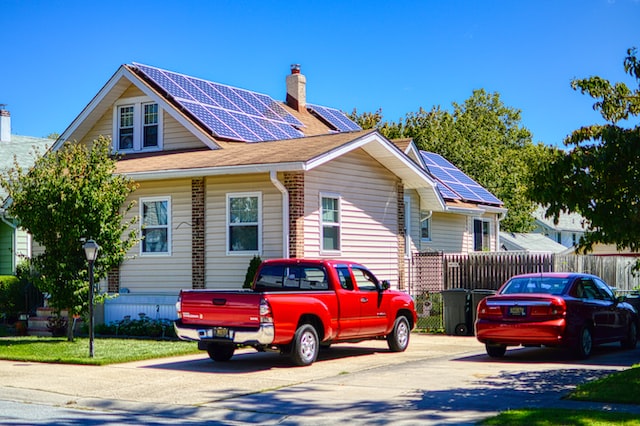The energy from the sun can be used to create clean, renewable electricity. Solar power is an excellent alternative to traditional electricity and can help you cut your energy bill, reduce your carbon footprint, and increase your independence from the grid.
Solar panels, also known as photovoltaic (PV) cells, turn sunlight into electricity by energizing electrons in semi-conductive materials. The electricity can be used to power household appliances and devices or stored in a solar battery for future use.
The Sun
The sun is the planet’s primary energy source, providing solar radiation that powers up the world’s electrical grid. In addition, it emits a continuous stream of electromagnetic energy, or EMR, in the form of photons.
These photons knock electrons free of their atoms in the semiconductor materials that make up a solar cell. These electrons are then collected and flow, creating an electric current.
This electric current flows from the cell to wires that connect to the positive and negative sides of the cell. It is then transferred to an inverter, which converts the direct current DC electricity to alternating (AC) electricity that we can use.
Solar power installed by professionals in EMT Solar & Roofing is an ideal renewable energy source, as it doesn’t emit greenhouse gases in its processes. It’s also a more sustainable and clean option than fossil fuels because it doesn’t pollute the air and doesn’t deplete natural resources.
Photovoltaic (PV) Cells
Photovoltaic cells work by absorbing or reflecting light that contains energy in photons. Then, they produce electricity by transferring the power of the photons to electrons within a semiconducting material.
Solar cells are made from various materials, including silicon, gallium arsenide, and copper indium diselenide. They are also available in flexible thin-film formats.
All PV cells have a built-in electric field that forces electrons freed by light absorption to flow in one direction. This current, transferred to metal contacts on the cell’s top and bottom, defines how much power it can generate.
Efficiency, or the amount of electricity a cell produces for each watt of sunlight it absorbs, varies based on the semiconductor’s bandgap and multiple performance attributes. The average efficiency of commercially available PV modules is around 15% but has improved rapidly since the mid-1980s.
PV cells are the core of solar energy systems despite their relatively low efficiency. They are used to power homes, businesses, and in utility-scale solar farms. They are also being deployed in remote locations that do not have access to electricity.
Modules
Modules are the primary building block of a solar power system and generate electrical energy. They are made up of individual solar cells, each with a semiconductor material like silicon.
When sunlight strikes a photovoltaic cell, the silicon converts it into an electron flow, which is then induced to flow through an external circuit. Each cell can only generate half a volt of electricity, but it takes many modules to power your home.
To increase the output power, several solar cells are connected in series. The number of cells in a module depends on the standard voltage requirement per module.
Each cell also has a metal sheet that collects the mobile electrons. They then go through an external circuit to do some electrical work, like powering a lightbulb, before returning through the aluminum sheet on the back of the cell.
The efficiency of a PV module is measured by the ratio of maximum power to open-circuit voltage and short-circuit current. It is called the fill factor (FF). High-efficiency PV modules range from 15 to 20%, with outliers on either end of the scale.
Inverters
Inverters convert solar panels’ direct current (DC) power into alternating current (AC) power. It can power domestic appliances and most industrial equipment or feed directly into the utility grid for front-of-the-meter projects (utility-scale solar arrays).
To accomplish this, inverters use electronic components called integrated gate bipolar transistors, or IGBTs. The IGBTs chop the DC into pulses, and other circuits shape the pulses into a sine wave.
Some inverters, brilliant ones for solar-plus-battery systems, have built-in energy storage. These storage devices are designed to buffer the panel’s output when the AC voltage drops below a specific voltage.
These systems can also handle zero-crossings, which are periods where the AC is in a straight line and no voltage is developed by the PV cell. Inverters can also monitor voltage and current and react to changes in these conditions.
According to PVEL’s report, inverters perform more operational functions than any other component of a PV system, including detecting and responding to voltage and frequency fluctuations. Smart inverters can even ride through these irregularities to keep your solar system functioning or shut down when the disruptions are long enough to affect generation.
Storage
Storage is an integral part of the solar power production process. It helps smooth out variations in how much solar energy flows on the grid at different times, including during cloudy days or after the sun sets.
There are many different types of storage for solar power. Currently, batteries are the most common form of solar storage.
Batteries store energy by converting a chemical reaction between battery components into electricity, which can be used in the future. In addition, new battery technology is continually being developed, allowing for cheaper and more scalable systems.
Solar + battery storage is an emerging solution for maximizing the value of solar electricity to the grid. It is because the battery system stores any excess solar energy that’s not immediately needed by the home, reducing the amount of electricity you have to feed into the grid and thereby increasing your savings on your utility bill.



